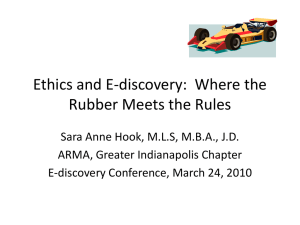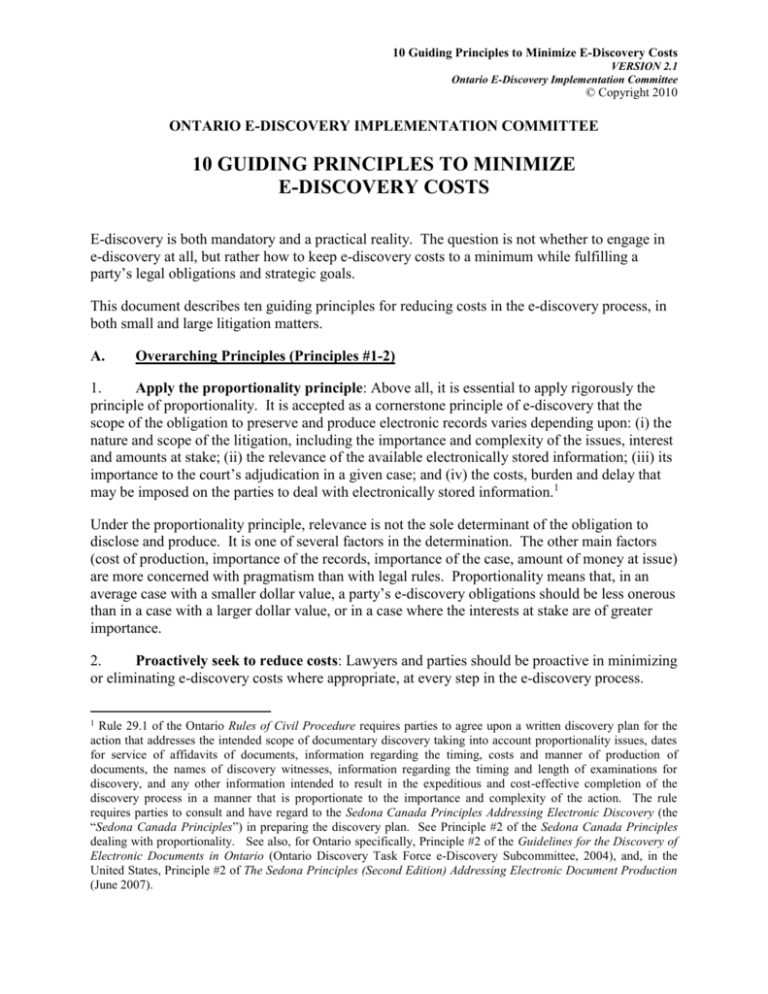
10 Guiding Principles to Minimize E-Discovery Costs
VERSION 2.1
Ontario E-Discovery Implementation Committee
© Copyright 2010
ONTARIO E-DISCOVERY IMPLEMENTATION COMMITTEE
10 GUIDING PRINCIPLES TO MINIMIZE
E-DISCOVERY COSTS
E-discovery is both mandatory and a practical reality. The question is not whether to engage in
e-discovery at all, but rather how to keep e-discovery costs to a minimum while fulfilling a
party’s legal obligations and strategic goals.
This document describes ten guiding principles for reducing costs in the e-discovery process, in
both small and large litigation matters.
A.
Overarching Principles (Principles #1-2)
1.
Apply the proportionality principle: Above all, it is essential to apply rigorously the
principle of proportionality. It is accepted as a cornerstone principle of e-discovery that the
scope of the obligation to preserve and produce electronic records varies depending upon: (i) the
nature and scope of the litigation, including the importance and complexity of the issues, interest
and amounts at stake; (ii) the relevance of the available electronically stored information; (iii) its
importance to the court’s adjudication in a given case; and (iv) the costs, burden and delay that
may be imposed on the parties to deal with electronically stored information.1
Under the proportionality principle, relevance is not the sole determinant of the obligation to
disclose and produce. It is one of several factors in the determination. The other main factors
(cost of production, importance of the records, importance of the case, amount of money at issue)
are more concerned with pragmatism than with legal rules. Proportionality means that, in an
average case with a smaller dollar value, a party’s e-discovery obligations should be less onerous
than in a case with a larger dollar value, or in a case where the interests at stake are of greater
importance.
2.
Proactively seek to reduce costs: Lawyers and parties should be proactive in minimizing
or eliminating e-discovery costs where appropriate, at every step in the e-discovery process.
1
Rule 29.1 of the Ontario Rules of Civil Procedure requires parties to agree upon a written discovery plan for the
action that addresses the intended scope of documentary discovery taking into account proportionality issues, dates
for service of affidavits of documents, information regarding the timing, costs and manner of production of
documents, the names of discovery witnesses, information regarding the timing and length of examinations for
discovery, and any other information intended to result in the expeditious and cost-effective completion of the
discovery process in a manner that is proportionate to the importance and complexity of the action. The rule
requires parties to consult and have regard to the Sedona Canada Principles Addressing Electronic Discovery (the
“Sedona Canada Principles”) in preparing the discovery plan. See Principle #2 of the Sedona Canada Principles
dealing with proportionality. See also, for Ontario specifically, Principle #2 of the Guidelines for the Discovery of
Electronic Documents in Ontario (Ontario Discovery Task Force e-Discovery Subcommittee, 2004), and, in the
United States, Principle #2 of The Sedona Principles (Second Edition) Addressing Electronic Document Production
(June 2007).
2
10 Guiding Principles to Minimize E-Discovery Costs
VERSION 2.1
Ontario E-Discovery Implementation Committee
© Copyright 2010
Cost reduction must be approached in a methodical, thoughtful way. It is important to identify
the main types of cost – there are three of them: legal fees, consultants’ fees, and employee time
– and the stages in the e-discovery process at which each type of cost is incurred. Once the costs
are broken down and identified in this methodical way, parties and their counsel can make
informed decisions about whether to incur the specific cost, and how to keep the cost low.
Legal fees are predominantly incurred in the review of documents for relevance and privilege,
conducting oral discovery, and litigating contested discovery disputes. Consultants’ fees are
most often incurred in preserving, identifying, processing and producing relevant documents.
Employee time is most significantly consumed in implementing a litigation hold, searching for
potentially responsive records, and reviewing documents for relevance or privilege. The
recommendations below identify suggested means of reducing each type of cost at all relevant
stages.
B.
Minimizing Costs by Proactive Pre-Litigation Steps (Principles #3-5)
3.
Manage records effectively: An effective and properly implemented records
management system (including a formal retention and destruction policy) can reduce the
universe of records to be searched,2 and can greatly facilitate the process of identifying
repositories of potentially relevant records. Fewer records means less search time, and fewer
documents to review. The cost reduction is direct and immediate. Having well-organized
records similarly reduces search time, and may lower or eliminate the need to have external
consultants or legal counsel assist in the process of locating relevant records. It is also easier to
justify an e-discovery plan to a court (if required) where a party can demonstrate the
effectiveness of its records management system in grouping and identifying potentially relevant
material.
4.
Achieve discovery readiness - the litigant: Any party that reasonably anticipates
litigation as an incident of doing business will ultimately benefit from implementing a discovery
readiness plan in advance.3
The plan should, among other things, include procedures and forms for implementing a litigation
hold, designate a person responsible for responding to discovery requests, prescribe procedures
for conducting searches for relevant records (including identifying any internal software tools to
be used in searching for records), and identify any internal IT personnel or external litigation
support consultants the party may wish to contact. Where a party intends to conduct e-discovery
steps without the assistance of outside consultants or counsel, the discovery readiness plan
2
For example, a records retention policy that provides for regular recycling of backup media on a short recycling
schedule, such as every seven days, will largely eliminate backup media as a source of potentially relevant records
except in rare cases, thus eliminating a potentially significant e-discovery cost. (See Principle #3 of the Sedona
Canada Principles, and in particular Comment 3.i.) Similar benefits can flow from implementing an email retention
policy that provides for regular destruction of unfiled email. Any records retention policy should be reviewed by
litigation counsel before implementation to ensure it is reasonable and does not provide for premature destruction of
records.
3
See Principle #3 of the Sedona Canada Principles, and in particular Comment 3.b.
3
10 Guiding Principles to Minimize E-Discovery Costs
VERSION 2.1
Ontario E-Discovery Implementation Committee
© Copyright 2010
should explain how to search for and collect electronic records in a manner that preserves their
integrity, and that does not alter metadata. The plan should be prepared with input from
litigation counsel to ensure it is complete and correct.
A discovery readiness plan can be simple or complex depending upon the needs and
sophistication of the party. Even for a party that intends to rely entirely on outside consultants
and legal counsel to identify and collect relevant records, a discovery readiness plan that
provides a step by step guide to implementing the litigation hold and contacting the appropriate
professionals will streamline the litigation process at the front end, reducing legal fees and
avoiding wasted employee time.
5.
Achieve discovery readiness - the law firm: Lawyers can reduce their client’s ediscovery costs by following a system and having precedents available to advise and assist the
client in the discovery process. There should be a precedent memo explaining the litigation hold
process (with a precedent litigation hold notice) that can be provided to the client as soon as the
file is opened.4 The use of such e-discovery precedents minimizes the legal fees associated with
advising the client on preservation issues, while at the same time ensuring the client is properly
advised. There are a variety of other e-discovery precedents that a lawyer may usefully employ,
such as precedent preservation letters, meet and confer agreements, information packages on the
discovery process, chain of custody documentation, discovery questions, and the like.5
Similarly, lawyers can save their clients money by regularly following a pre-set checklist of ediscovery procedures, rather than “reinventing the wheel” with each new matter. The lawyer
should also be in a position to advise the client on discovery steps that the client may effectively
dispense with in a particular case, or that the client may carry out itself rather employing
consultants or lawyers, in order to reduce costs.
C.
Minimizing Costs During Litigation (Principles #6-10)
6.
Reduce the involvement of lawyers: Legal fees generally constitute the largest dollar
amount of discovery costs. Any work that does not need to be done by lawyers in a particular
case should not be.
Counsel and their clients should consider each step in the discovery process and determine
whether, in the circumstances of the case, lawyer involvement is required. For example, today’s
sophisticated e-discovery search software can be equally or more effective than manual review
by lawyers in identifying relevant documents. In appropriate cases, these tools can be used in
See the Ontario E-Discovery Implementation Committee’s Model Document #3: Memorandum to Corporate
Client Regarding Documentary Discovery, and Model Document #4: Memorandum to an Individual Client
Regarding Documentary Discovery, available at www.oba.org
5
The Ontario E-Discovery Implementation Committee has prepared model discovery plans and discovery
agreements, as well as a model preservation order, model memoranda to a client (individual or corporate), and
model preservation letters.
They are available at http://www.oba.org/En/publicaffairs_en/EDiscovery/model_precedents.aspx
4
4
10 Guiding Principles to Minimize E-Discovery Costs
VERSION 2.1
Ontario E-Discovery Implementation Committee
© Copyright 2010
lieu of lawyer review.6 In other cases, clients may wish to search for responsive documents
themselves, or to review documents for relevance and privilege internally in appropriate cases, as
a means of eliminating potentially significant legal costs.
Similarly, lawyers and clients should consider available methods of reducing the cost of the
lawyers’ work, even if lawyer involvement is required. This can involve increasing efficiency
(such as through use of precedents, pre-set procedures, and the like) or using lawyers who charge
a lower billable rate (such as contract lawyers, who can be engaged to review documents for
relevance and privilege at a much lower hourly rate than the average lawyer bills their client).
7.
Reduce the involvement of consultants: The same cost-reduction approach should be
taken to the hiring of e-discovery and computer forensics consultants. In appropriate cases, the
services of such consultants are indispensable. Where they are not indispensable, serious
consideration should be given to minimizing their role in the case, if the client can accomplish
some or all of the necessary e-discovery steps on its own.
Institutional clients who are regularly engaged in litigation should consider bringing the
consultants’ expertise in house, and acquiring some of the key software tools used by consultants
to preserve, search and review electronic records.
8.
Limit the scope of e-discovery: The scope of e-discovery can and must be limited,
whether by agreement with the other parties to the litigation, by court order, or by a party’s
unilateral decision. Parties should limit the range of records to be produced by date, author,
recipient, custodian, file format, data type, and search terms.7 Where it would be
disproportionately onerous for a party to produce certain records (for example, because the cost
of retrieval outweighs the minimal likely relevance), a decision or agreement should be reached
to defer or avoid their production.8 Any discovery step that is not required in order to comply
with the law or to pursue the party’s strategic objectives should simply not be undertaken.
9.
Cooperate: Parties should conduct e-discovery by agreement where possible,
cooperating with one another to reduce costs and streamline the proceedings.9 Cooperation can
help to limit the scope of e-discovery, can eliminate unnecessary discovery steps, and can take
away the need for expensive motions to address contested issues.
10.
Use technology effectively: The effective use of litigation software is essential in order
to conduct e-discovery. There is now a wide range of relatively cheap and easy to use software
programs to assist lawyers and their clients in copying, indexing, searching, filtering, deduplicating, coding, reviewing and producing their electronically stored information. Lawyers
should become familiar with the available software, including some of the now very user
friendly and helpful programs that can be installed and administered directly by the client. Used
6
7
8
9
See Principle #7 of the Sedona Canada Principles, and in particular Comment 7.c.
See Principle #7 of the Sedona Canada Principles, and in particular Comment 7.b.
See Principle #5 of the Sedona Canada Principles, and in particular Comment 5.a.
See Principle #4 of the Sedona Canada Principles.
5
10 Guiding Principles to Minimize E-Discovery Costs
VERSION 2.1
Ontario E-Discovery Implementation Committee
© Copyright 2010
effectively, technology can reduce the universe of records, reduce required lawyer time, and
streamline the e-discovery process.10
Conclusion
Every e-discovery cost represents a decision made by the party and their counsel. The right
decisions, especially if made proactively, can significantly reduce the costs in both dollars and
time. The disruption and inconvenience of e-discovery cannot be eliminated, but its burden can
be minimized.
Note regarding use of this document
This document and all of the EIC’s model documents and other publications are available on the
Ontario Bar Association's website at:
http://www.oba.org/En/publicaffairs_en/E-Discovery/model_precedents.aspx
This document has been prepared and made available to the public by the EIC for informational
purposes. It is not provided as legal or technical advice and should not be relied upon as such.
Publications of the EIC are copyrighted by the Ontario E-Discovery Implementation Committee
and all rights are reserved. Individuals may download these publications for their own use at no
charge. Law firms and other organizations may download these publications and make them
available internally for individual use within the firm or organization. EIC publications may be
republished, copied or reprinted at no charge for non-profit purposes. Organizations and
individuals may provide a link to the publications on the internet without charge provided that
proper attribution to the Ontario E-Discovery Implementation Committee is included. For further
information, or to request permission to republish, copy or reprint for commercial profit, contact
the Chair of the Committee, David Outerbridge, at douterbridge@torys.com.
Feedback on EIC materials
The EIC welcomes comments on all of its model documents and other publications. Any
comments or suggestions can be provided to Michele A. Wright at mwright4@toronto.ca.
10
See Principle #7 of the Sedona Canada Principles.
10 Guiding Principles to Minimize E-Discovery Costs
VERSION 2.1
Ontario E-Discovery Implementation Committee
© Copyright 2010

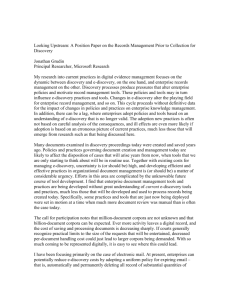
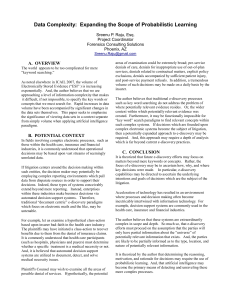
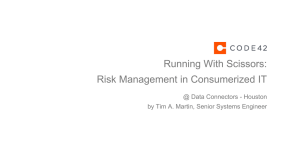
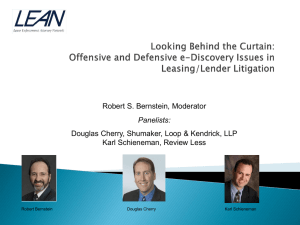
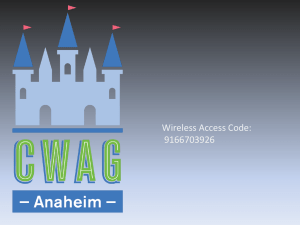
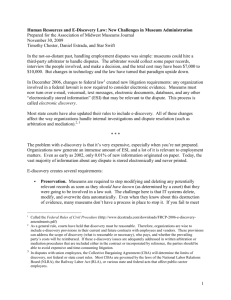
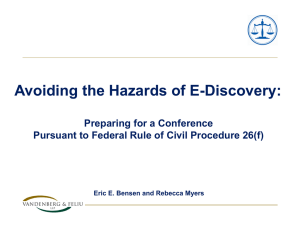
![Job Title [Position]: E-Discovery Technology Analyst Job Category](http://s3.studylib.net/store/data/006902182_1-1691051d5b109ca41d9e22efa1a51300-300x300.png)

